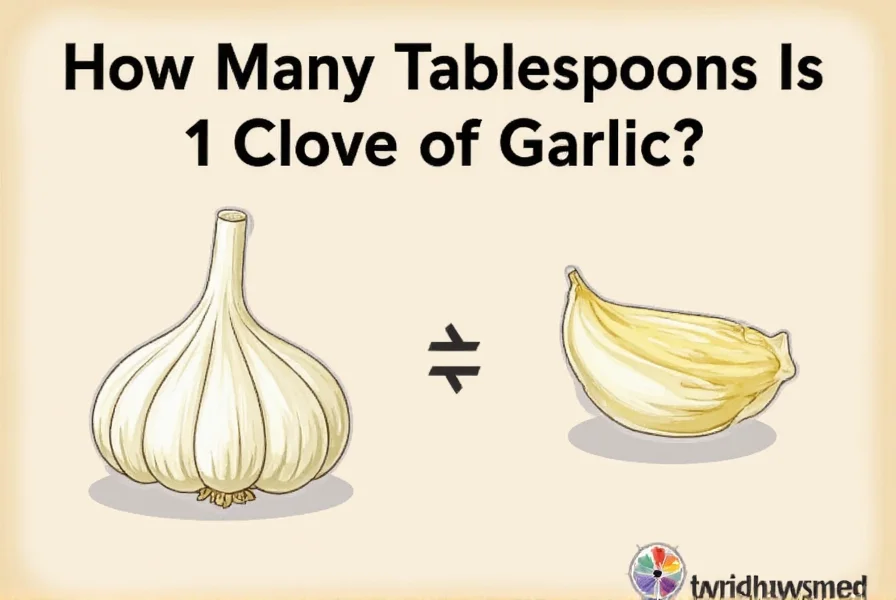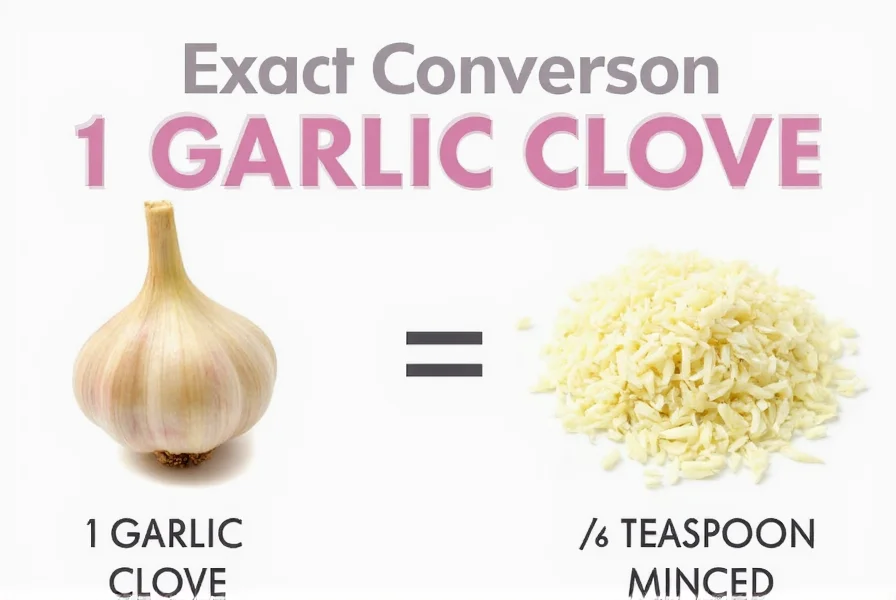Understanding garlic measurements is essential for achieving perfect flavor balance in your recipes. While the precise conversion depends on clove size and preparation method, this guide provides accurate measurements you can rely on in the kitchen.
Why Garlic Measurement Accuracy Matters
Garlic’s potent flavor can make or break a dish. Too little leaves recipes bland, while too much overwhelms other ingredients. Unlike dry spices where small variations matter less, fresh garlic’s intensity requires more precise measurement, especially in delicate sauces, dressings, and baked goods.
Garlic Clove to Tablespoon Conversion Chart
| Garlic Form | 1 Small Clove | 1 Medium Clove | 1 Large Clove |
|---|---|---|---|
| Minced Garlic | ¼ tsp (0.08 tbsp) | ½ tsp (0.17 tbsp) | ¾ tsp (0.25 tbsp) |
| Chopped Garlic | ⅛ tsp (0.04 tbsp) | ¼ tsp (0.08 tbsp) | ½ tsp (0.17 tbsp) |
| Garlic Paste | ⅛ tsp (0.04 tbsp) | ¼ tsp (0.08 tbsp) | ½ tsp (0.17 tbsp) |
These measurements reflect the actual volume of prepared garlic, not the whole clove. When recipes specify “minced garlic,” they refer to the post-preparation quantity, which is significantly less than the whole clove’s volume.

Factors Affecting Garlic Measurements
Several variables influence how much usable garlic you get from a single clove:
Clove Size Variability
Garlic cloves vary dramatically in size. A single head may contain both tiny inner cloves and large outer cloves. Standard conversions assume medium-sized cloves (about 1 inch long and ¼ inch in diameter). When precision matters, count cloves rather than estimating by size.
Preparation Method Differences
The way you prepare garlic significantly impacts volume:
- Minced: Finely chopped garlic yields the most volume (about ½ tsp per medium clove)
- Chopped: Larger pieces create air pockets, resulting in less dense measurement
- Pressed: Garlic press extracts maximum flavor but compacts the volume
- Roasted: Cooking reduces volume by 30-40% due to moisture loss
Practical Kitchen Applications
Understanding how many tablespoons is 1 clove of garlic helps when adapting recipes. Consider these real-world scenarios:
When Precision Is Critical
For aioli, mayonnaise-based dressings, or delicate fish dishes, use exact measurements. In these cases, how much minced garlic equals one clove in tablespoons directly impacts emulsion stability and flavor balance. Use a microplane grater for the most consistent results.
When Approximation Works
For hearty stews, roasted vegetables, or tomato sauces, the exact tablespoon equivalent of one garlic clove matters less. In these applications, taste as you go and adjust accordingly. Remember that raw garlic has sharper flavor than cooked garlic.

Common Measurement Mistakes to Avoid
Cooks frequently misjudge garlic quantities. Watch for these pitfalls:
- Confusing whole clove volume with prepared volume: A whole medium clove might fill ¼ tablespoon, but after mincing, it yields only ½ teaspoon (⅙ tablespoon)
- Ignoring garlic variety differences: Solo garlic (single clove) is more potent than standard multi-clove heads
- Not accounting for age: Older garlic dries out, yielding less volume when prepared
- Using jarred minced garlic incorrectly: Preservatives change texture and potency—use 1:1.5 ratio (1 clove fresh = 1½ parts jarred)
Converting Recipes Successfully
When adapting recipes that specify cloves but you have pre-minced garlic, or vice versa, use these conversion principles:
If a recipe calls for “3 cloves garlic,” and you’re using minced garlic from a jar, measure 1½ teaspoons (or ½ tablespoon). For the reverse conversion (minced to cloves), remember that how many tablespoons per garlic clove translates to 3 cloves equaling approximately ½ tablespoon minced.
Professional chefs often keep a garlic conversion cheat sheet in their kitchen. The most reliable approach for critical recipes is to actually measure your minced garlic rather than estimating. A small digital scale provides the most accurate results—one medium minced clove weighs approximately 3 grams.
Frequently Asked Questions
How many tablespoons is 1 clove of garlic when minced?
One medium garlic clove yields approximately 0.17 tablespoons (1/6 tablespoon) of minced garlic. This equals ½ teaspoon, since 3 teaspoons make 1 tablespoon. Small cloves yield about 0.08 tablespoons, while large cloves provide up to 0.25 tablespoons.
What's the difference between chopped and minced garlic measurements?
Minced garlic packs more densely than chopped, yielding about double the volume. One medium clove produces ½ teaspoon minced (0.17 tbsp) but only ¼ teaspoon chopped (0.08 tbsp). For precise recipes, always specify your preparation method when measuring.
How do I convert 4 cloves of garlic to tablespoons?
Four medium garlic cloves equal approximately 2 teaspoons of minced garlic, which converts to ⅔ tablespoon (0.67 tbsp). For small cloves, use ½ tablespoon; for large cloves, use 1 tablespoon. Remember that 3 teaspoons = 1 tablespoon when making these conversions.
Does roasted garlic yield the same tablespoon measurement as raw?
No, roasted garlic yields about 30% less volume than raw due to moisture loss during cooking. One medium raw clove (½ tsp raw) becomes approximately ⅛ teaspoon (0.04 tbsp) when roasted. Account for this reduction when substituting roasted for raw garlic in recipes.
How many garlic cloves equal 1 tablespoon of minced garlic?
Six medium garlic cloves equal approximately 1 tablespoon of minced garlic. This is because each medium clove yields ½ teaspoon minced, and 6 × ½ tsp = 3 tsp = 1 tbsp. For small cloves, you'll need 8-9; for large cloves, 4-5 should suffice.










 浙公网安备
33010002000092号
浙公网安备
33010002000092号 浙B2-20120091-4
浙B2-20120091-4